JAXA Astronaut Activity Report, June, 2013
Last Updated: August 23, 2013
This is JAXA's Japanese astronaut primary activity report for June, 2013.
Astronaut Koichi Wakata continues training for an upcoming long-duration ISS mission in the US
Astronaut Koichi Wakata, assigned as a crew member for the Expedition 38/39 mission to the International Space Station (ISS) underwent training for a long-duration mission at the NASA Johnson Space Center (JSC), focusing on Extravehicular Activity (EVA) and medical experiments.
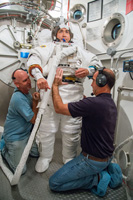
Wakata donning EMU in the SSATA (Credit: JAXA/NASA)
During the training for EVA, Wakata confirmed EVA preparation procedure in a vacuum chamber called the Space Station Airlock Test Article (SSATA), the on-ground facility featuring the Quest Joint Airlock function. He used a spacesuit with functions equivalent to the real Extravehicular Mobility Unit (EMU) used on the ISS. Wakata simulated EMU preparation, EVA tool preparation, and procedure to prevent decompression sickness as if it was a real EVA. Then, donning EMU, he executed procedure from SSATA depressurization to going outboard. Besides the preparation procedure, the EVA training included maintaining Orbital Replacement Units (ORUs) and using EVA tools.
Various training of medical experiments included experiments to see how a long-term stay under microgravity affects human being, in terms of oxygen uptake measurements, eyesight, cognitive ability, and circadian rhythms, as well as development of an exercise program to effectively minimize muscle atrophy and bone loss and assess looking ahead to the future interplanetary manned mission if a long-duration space mission affects the operating skill of a Lander. While increasing understanding on each theme, he took pre-flight baseline medical data. Besides, he confirmed how to use hardware to measure a body mass and tonometer.
In addition, Wakata went through various activities on how to respond to fire on the ISS and use ISS galley as well as set up and communicate with the ground via amateur ham radio under ARISS (Amateur Radio on the International Space Station) program.
Astronaut Kimiya Yui's training in Russia for a long-duration ISS mission
Astronaut Kimiya Yui, assigned as a crew member for the ISS Expedition 44/45 mission,
underwent training for upcoming ISS long-duration mission at the Gagarin Cosmonaut Training Center (GCTC).
The training focused on the Soyuz rendezvous and docking operations to the ISS and the life support system of the Soyuz spacecraft including Sokol spacesuits. Yui deepened understanding through lectures and acquired technique using a simulator.

Yui and other astronauts participating in the water survival training (Credit: JAXA/GCTC)
From June 18-21, he underwent water survival training held in the EMERCOM facility in Noginsk, a Moscow suburb. This training is held for astronauts to acquire skills needed to survive until they are rescued in a case that the Soyuz spacecraft is forced to make an emergency landing on water, e.g. splashdown.
Yui participated in this training with Russian cosmonaut Oleg Kononenko and NASA astronaut Kjell Lindgren. In the training, the trio boarded the Soyuz descent module mockup floating on the water. They practiced changing to hydrosuits / snowsuits and setting up survival equipments, and learned procedure for escaping from the floating module and making a trilateral formation on the water. The training also included responding to secondary accidents such as flooding and fire.
Astronaut Akihiko Hoshide resumes technical duty in the NASA Astronaut Corps
Completing post-flight activities, astronaut Akihiko Hoshide has returned to technical duty in the NASA Astronaut Corps. Currently he serves as a Capsule Communicator (CAPCOM) and also engages in activity in the ISS Integration Branch.
Alongside astronauts' training, all astronauts who belong to the NASA Astronaut Corps are to engage in astronauts office's activities.
Hoshide has served as a CAPCOM before. CAPCOM's duty is to communicate with the crew on the ISS representation on-ground flight control teams. In June, he attended as a CAPCOM for training simulating that there was an anomaly happened on the ISS.
The ISS Integration Branch coordinates a series of groups who make inter-departmental adjustment to such points as Operation Data File (ODF) writing and instruction tool improvement for the ISS crew.
Astronaut Soichi Noguchi participates in the unveiling event of a Smartphone application "kibo360°"
On June 14, astronaut Soichi Noguchi appeared in the commemorative event of unveiling of the Smartphone application "kibo360°" held in the Apple Store in Ginza, Tokyo.
kibo360° is an application for Smartphone that allows you to look around 360 degrees inside the Japanese Experiment Module "Kibo" and makes you feel as if you are on Kibo.
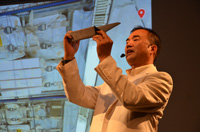
Noguchi demonstrates kibo360° (Credit: JAXA)
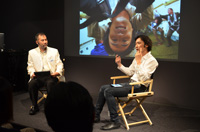
Mr. Togi speaks about zero-gravity experience (Credit: JAXA)
At the beginning of the event, Noguchi demonstrated the application and talked about his experience in Kibo.
After the demonstration, Mr. Hideki Togi, a traditional musician of gagaku (Japanese court music), having an experience of participating in cosmonaut training in Russia appeared to hold a talk session under the lead of Noguchi. In the talk session, Mr. Togi told that when he visited Russia's Star City, known as the leading edge of space development, he found that it still uses the well-seasoned training facility from its early times. He also talked enthusiastically about his parabolic flight experience. Audience listened with great interest. Besides, various subjects such as what space and Togi's instrument have in common were discussed.
At the end of the session, Noguchi asked Mr. Togi what space means to him. "Space gives us dreams," then "going to space itself has a great meaning," Mr. Togi answered. Listening to Togi's comment, Noguchi reminisced about his long-term stay in space and concluded the session mentioning that it was worth everything when he saw our mother Earth from Kibo's window."
Astronaut Furukawa delivered a lecture in the space school in Saga
On June 27, astronaut Satoshi Furukawa was invited to deliver a lecture in the "Third Space School in Taku city" in Saga prefecture, held to commemorate the opening of the city's unified primary and junior high school.
In the lecture, Furukawa spoke about his aspiration to be an astronaut, explained everyday training, duty on the ISS and how the Earth looks from the ISS. The children were all ears to his talks. Finally, he yelled a message to pupils.
Astronaut Takuya Onishi holds lectures at the ISTS
On June 2, Astronaut Takuya Onishi lectured in Nagoya University, as a part of the 29th International Symposium on Space Technology and Science (ISTS), held in Nagoya city, Aichi prefecture.
ISTS intends to facilitate space development, develop the human resource in this field, and deepen exchange among domestic and international space specialists through workshops and discussion opportunities. In the field of Aerospace engineering, ISTS is the largest symposium in Japan. As well as holding workshops and discussions, ISTS also focuses on conducting events such as exhibitions and educational activities.
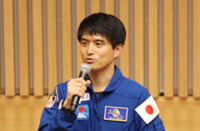
Onishi speaks to children (Credit: JAXA)
The lecture comprised two parts. In the first part, Onishi held a talk session targeting elementary and junior high school students. In the session, children were given opportunity to directly ask questions to Onishi about astronauts' job, training and how to be an astronaut.
In the second part, he gave lecture to general public and held a panel discussion. In the lecture, he introduced the overview of the ISS and daily training, as well as his aspiration to be an astronaut. Then, in the last half of the second part, Onishi participated as one of the panelists in the panel discussion. They discussed the meaning and purposes of manned space development.
Astronaut Chiaki Mukai attended the "50 Years of Women in Space"
Between June 12-21, the 56th session of the Committee on the Peaceful Uses of Outer Space (COPUOS) was held in Vienna, Austria. Astronaut Chiaki Mukai participated in the talk session titled "Women in Space: The Next 50 Years" in the Natural History Museum in Vienna during the course of the session.
The talk session was held to celebrate the 50th anniversary since Valentina Tereshkova's first space flight as a woman. In addition to Mukai, female astronauts from Russia, US, Canada, and China participated in the session.
The talk session was held to celebrate the 50th anniversary since Valentina Tereshkova's first space flight as a woman. In addition to Mukai, female astronauts from Russia, US, Canada, and China participated in the session.
New Astronauts at the Front-Line
*Astronaut Yui’s journal is not available this month.

It’s a certain sunny Thursday in June and former astronauts from all over America are gathering at NASA’s Johnson Space Center in Houston.
They are gathering in order to participate in the Astronaut Reunion which takes place once every 2 years. A reunion is what, in Japan, we would call an alumni meeting. The retired astronauts come home to Houston, where they spent their training years, to visit and also to undergo medical checks.
The programme includes a get-together as well as all kinds of briefings and facility tours and it is customary for the new astronaut class to man the secretariat for this event. This means that my class of 2009 was in charge of making the arrangements this time.
Along with this year’s reunion, another ceremony was held at the Johnson Space Centre: a memorial ceremony for Neil Armstrong, who passed away last August.
Neil Armstrong is, of course, known as the commander of Apollo 11, which accomplished the first moon landing, and as the first person to walk on the moon. And the words he uttered at that moment, ‘That’s one small step for man; one giant leap for mankind,’ became famous all over the world.
Apollo 11, which indelibly etched glory into the history of American, no, global space development history. A ceremony to mourn the death of its commander was held at Johnson Space Center.
The other two Apollo 11 crew members, Buzz Aldrin and Michael Collins. Many celebrated astronauts attended the memorial including the Apollo 17 commander, Eugene Cernan, the last person to walk on the moon to this day (I would like to stress the words ‘to this day’).
There were speeches from Buzz and Michael and other people who knew Neil well but the thing that everyone was talking about was how excellent an astronaut Neil was and that he was someone who always kept his cool and never became flustered.
For example, Michael was asked by his father if he would manage to become an astronaut when he had got to the last stage of selection tests for the second generation of astronauts after NASA’s Mercury 7 and he replied, ‘I don’t know about me. All I know is that there is no doubt that Neil Armstrong will be selected.’
In actual fact, Neil was selected as one of The New Nine group formed at that time. Michael was not selected for this group but passed the next selection with flying colours.
The Apollo 11 moon landing caused a sudden upheaval in Neil’s environment but I hear that even this did not change him in any way and, to the end, he never misused his fame.
While I attended the ceremony, I was thinking that the evaluation of a life may not finally be decided until the person in question has lived out their life or even well after that.
Once the ceremony in the big hall was over, a Tree Dedication Ceremony was held in a grove near to the entrance of the Space Center. After praising Neil’s achievements, a large oak was dedicated to him.
A replica of Neil’s first footstep on the moon, converted into a 3D model from a photograph, was laid in front of the tree. His close friends and family laid roses at the bottom of the tree. Among them were his two sons, Eric and Mark who represented the bereaved family and both gave speeches.
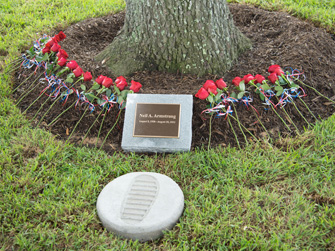
Roses laid at the foot of the tree and a replica of Neil’s first footstep on the moon.
First of all, the younger brother, Mark, spoke from the microphone set up in the shadow of the tree.
‘I have been living in the shadow of my father for a very long time,’ he said.
Then Mark paused, looked up at the tree that was dedicated to his father and said,
‘Dad, even now, I’m talking in your shadow.’
This suddenly energised the crowd. As the child of a father who was so great, there must have been hardship and distress unimaginable to other people. It was a splendid moment when this changed to an eloquent joke.
It was Eric’s turn next. I was listening carefully as I was really interested in how he would follow such a witty speech from his younger brother. Looking exactly like his father, with a calm facial expression, he began to speak.
‘I learned a lot of things from my father. I would like to tell you about one of them today. When I was 12 years old, just like any other 12 year old boy in the world, I wasn’t scared of anything.
At the time, we had a dirt bike at home and, just like any other 12 year old boy in the world, I was always begging my Dad to let me ride it.
One day, when I was really pestering Dad, he took me to the garage. I was really excited.
Then Dad said to me, ‘I’ll let you ride the bike. There’s just one condition.’
I thought, ‘Here we go again.’ Give or take, I knew he would say that I had to study or help around the house or something like that. I was prepared for whatever conditions he imposed on me.
However, he gently laid the bike on the ground and said, ‘Pick it up.’
‘No trouble,’ I thought. And I tried to put the bike the right way up.
But it didn’t move an inch.
There was nothing I could say to this.
Here is another story. One night, I woke up in my bed and saw the room full of smoke. While I was blankly unaware of what was happening, my father ran into the room shouting, ‘Fire!’ and pulled me quickly outside.
Eric’s voice broke at this point and he looked up at his father’s tree with tears in his eyes, continuing to talk as if to the heavens.
‘My father. I owe a lot to my father.’
Eric’s speech really moved me.
Neil Armstrong, the astronaut who carved his name into history with the first ever moon landing. These magnificent speeches impressed on me that he was not only a great man but also a great father.
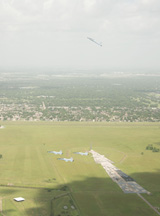
T-38s flying over the Johnson Space Center in the “missing man formation”
As the ceremony drew to a close, 4T-38s did a fly-over. The T-38s that made a clean V-shaped formation were visible as they flew towards us. A number of my classmates would either have been pilots or other crew in these planes. When they were right overhead the Johnson Space Center, one of the planes’ noses instantly lifted and it shot up towards the heavens.
This is the “missing man formation“.
Everyone in the crowd watched the sky indefinitely as the 4 T-38s disappeared from sight.
*Photos supplied by: JAXA/NASA

Hello everyone. This is Norishige Kanai.
The other day we got the news that 8 new astronauts had been selected to carry on with the future of US space development.
2009 (the actual recruitment and selection period was 2008), the year in which Mr. Yui, Mr. Onishi and I were selected, was a big year for astronaut selection when not only the US but also Europe, Canada and Japan held their own astronaut selection processes but this year, astronauts were only selected from the US (NASA).
I feel that there are many harsh opinions even when you look at manned space development from a global point of view that it is hugely expensive and whether the results really merit the amount of money being spent but I also feel that to dare to select future astronauts at a time like this sends the message that the US is in a position to lead the future of the Earth’s manned space development.
In actual fact, there are also private companies that are independently developing manned spacecraft and NASA, which is a government organization, is also considering a grand plan to pull asteroids from the moon’s sphere of gravitation and send astronauts to them to explore. When you work in Houston, you really feel the enthusiasm of the country of America as a whole for manned space development.
On the other hand, in the astronaut offices, my (American) classmates are pleased because they won’t be the newbies anymore and they won’t have to do all the chores.
Future manned plans are an important challenge on which we should focus but trifling matters such as who is going to buy the coffee beans and how the money is going to be collected are also very important from the point of view of workplace morale (I am sure this does not just apply to space development).
This is the same thing as in actual mission support, for example, when there is an emergency such as having to do unplanned extravehicular repairs on the space station because a major part has broken, everyone starts to work on solving the problem together saying things like: ‘The last time I was on the space station, I repaired the same part so I’ll pull an all-nighter and put together a procedure manual.” or “OK, I’ll go to that conference you’re scheduled for in your place.” or “I have extravehicular activity training planned in the pool so I can verify your procedure.”
You also get mails from people who are not directly related saying things like: “I am not working on anything urgent at the moment so if you need a hand, let me know!’
I am often asked if we fight on the space station because we spend so much time together in a confined space but when I am surrounded by such caring people who put others before themselves, I wouldn’t have the heart to fight with any of them.
By the way, it is very heartening to read a number of comments from you saying that you want to be astronauts.
Another question I am often asked is, ‘How do I become an astronaut?’ Personally, I think it might be a good idea to start thinking, on an everyday basis, about how you can help the people around you and how you can make it easier for your group to achieve its goals.
This doesn’t necessarily mean you have to start mental training to always think about what you can do with for the team, but in order develop teamwork with the other astronauts, various kinds of leadership training is conducted in places away from the regular place of work.
Examples of this are: the NEEMO training at the Aquarius Undersea Research Station in Florida in which Mr. Yui and Mr. Onishi participated, the CAVES project, cave exploration in Sardinia, Italy in which Mr. Noguchi and I participated and NOLS training, outdoor leadership training that is carried out all over the US.

Examples of this are: the NEEMO training at the Aquarius Undersea Research Station in Florida in which Mr. Yui and Mr. Onishi participated, the CAVES project, cave exploration in Sardinia, Italy in which Mr. Noguchi and I participated and NOLS training, outdoor leadership training that is carried out all over the US.
It seems a little strange to me that most of our training is outdoors in natural environments such as deserts, caves or underwater considering that we are astronauts but when you think about it, outer space can also be seen as a harsh natural environment of extremes and the utmost limits and the experience of resisting the discomforts of being outside, facing up to nature or risks such as accident or injury and overcoming difficulties as a group may be training that has a direct connection to actual space missions. (It’s probably not really for me to say, considering I haven’t been into space.)
I am waiting to be appointed to a mission in the future but in order to gain the trust of my team mates (not only astronauts but also controllers on the ground, engineers and managers in charge of operations) so that they say, ‘We can count on this guy,’ I work hard at daily training and my everyday work which I consider to be an indispensable part of my astronaut training.
*Photos supplied by: JAXA/ESA/V.Crobu










